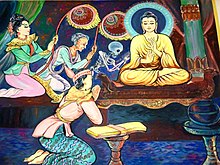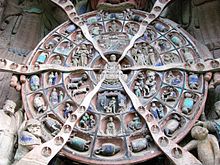Impermanence
This article's factual accuracy is disputed. (April 2022) |

Impermanence, also known as the
Dharmic religions
The Pali word for impermanence, anicca, is a compound word consisting of "a" meaning non-, and "nicca" meaning "constant, continuous, permanent".[1] While 'nicca' is the concept of continuity and permanence, 'anicca' refers to its exact opposite; the absence of permanence and continuity. The term is synonymous with the Sanskrit term anitya (a + nitya).[1][2] The concept of impermanence is prominent in Buddhism, and it is also found in various schools of Hinduism and Jainism. The term also appears in the Rigveda.[3][4]
Buddhism
| Part of a series on |
| Buddhism |
|---|
 |
| Translations of Impermanence | |
|---|---|
| English | Impermanence |
Tibetan | མི་རྟག་པ་ (Wylie: mi rtag pa, THL: mi tak pa) |
| Tagalog | anissa |
| Thai | อนิจจัง (RTGS: anitchang) |
| Vietnamese | vô thường |
| Glossary of Buddhism | |

Impermanence, called anicca (Pāli) or anitya (Sanskrit), appears extensively in the Pali Canon[1] as one of the essential doctrines of Buddhism.[1][5][6] The doctrine asserts that all of conditioned existence, without exception, is "transient, evanescent, inconstant".[1] All temporal things, whether material or mental, are compounded objects in a continuous change of condition, subject to decline and destruction.[1][2] All physical and mental events are not metaphysically real. They are not constant or permanent; they come into being and dissolve.[7]
Anicca is understood in Buddhism as the first of the
All physical and mental events, states Buddhism, come into being and dissolve.[10] Human life embodies this flux in the aging process, the cycle of repeated birth and death (Samsara), nothing lasts, and everything decays. This is applicable to all beings and their environs, including beings who have reincarnated in deva (god) and naraka (hell) realms.[11][12]
Anicca is intimately associated with the doctrine of
Everything, whether physical or mental, is a formation (Saṅkhāra), has a dependent origination and is impermanent. It arises, changes and disappears.[17][18] According to Buddhism, everything in human life, all objects, as well as all beings whether in heavenly or hellish or earthly realms in Buddhist cosmology, is always changing, inconstant, undergoes rebirth and redeath (Samsara).[11][12] This impermanence is a source of dukkha. This is in contrast to nirvana, the reality that is nicca, or knows no change, decay or death.[1]
Rupert Gethin on Four Noble Truths says:[19]
As long as there is attachment to things that are
unstable, unreliable, changing and impermanent,
there will be suffering –
when they change, when they cease to be
what we want them to be.
(...)
If craving is the cause of suffering, then the cessation
of suffering will surely follow from 'the complete
fading away and ceasing of that very craving':
its abandoning, relinquishing, releasing, letting go.
Hinduism
The term Anitya (अनित्य), in the sense of impermanence of objects and life, appears in verse 1.2.10 of the
Buddhism and Hinduism share the doctrine of Anicca or Anitya, that is "nothing lasts, everything is in constant state of change"; however, they disagree on the Anatta doctrine, that is whether Self exists or not.[7] Even in the details of their respective impermanence theories, state Frank Hoffman and Deegalle Mahinda, Buddhist and Hindu traditions differ.[23] Change associated with Anicca and associated attachments produces sorrow or Dukkha asserts Buddhism and therefore need to be discarded for liberation (nibbana), while Hinduism asserts that not all change and attachments lead to Dukkha and some change – mental or physical or self-knowledge – leads to happiness and therefore need to be sought for liberation (moksha).[23] The Nicca (permanent) in Buddhism is anatta (non-soul), the Nitya in Hinduism is atman (Self).[9]
Western philosophy
| Part of a series on |
| Philosophy |
|---|
Impermanence first appears in
Impermanence was widely but not universally accepted among subsequent Greek philosophers. Democritus' theory of atoms entailed that assemblages of atoms were impermanent.[26] Pyrrho declared that everything was astathmēta (unstable), and anepikrita (unfixed).[27] Plutarch commented on impermanence saying "And if the nature which is measured is subject to the same conditions as the time which measures it, this nature itself has no permanence, nor "being," but is becoming and perishing according to its relation to time.[28] The Stoic philosopher, Marcus Aurelius' Meditations contains many comments about impermanence, such as “Bear in mind that everything that exists is already fraying at the edges, and in transition, subject to fragmentation and to rot.” (10.18)[29]
Plato rejected impermanence, arguing against Heraclitus:[30]
How can that be a real thing which is never in the same state? ... for at the moment that the observer approaches, then they become other ... so that you cannot get any further in knowing their nature or state .... but if that which knows and that which is known exist ever ... then I do not think they can resemble a process or flux ....
Several famous Roman Latin sayings are about impermanence, including
In arts and culture
- Mujo(also known as This Transient Life) owes its title to the doctrine of Impermanence.
- Impermanence is the title of a novella written by Daniel Frisano.
- Impermanence is the title of the 7th track on For Those That Wish To Exist by Architects.
See also
References
- ^ ISBN 978-81-208-1144-7.
- ^ ISBN 978-1-4008-4805-8.
- ISBN 978-0-306-47151-3.
- ISBN 978-3-11-009896-9.
- ^ ISBN 978-1-134-90352-8., Quote: "All phenomenal existence [in Buddhism] is said to have three interlocking characteristics: impermanence, suffering and lack of soul or essence."
- ^ ISBN 978-1-4008-4805-8.
- ^ ISBN 978-1-134-79348-8.
- )
- ^ ISBN 978-81-208-3248-0.
- ^ Anicca Buddhism, Encyclopædia Britannica (2013)
- ^ ISBN 978-0-19-966383-5.
- ^ ISBN 978-0-521-85942-4.
- ^ Anatta Buddhism, Encyclopædia Britannica (2013)
- ISBN 978-1-134-90352-8., Quote: "(...) Buddha's teaching that beings have no soul, no abiding essence. This 'no-soul doctrine' (anatta-vada) he expounded in his second sermon."
- ISBN 978-0-521-85241-8.
- ISBN 978-1-4384-3921-1.
- ISBN 978-0-415-33234-7.
- ISBN 978-0-19-157917-2.
- ISBN 978-0-19-160671-7.
- ^ Katha Upanishad 1.2.10, Wikisource; Quote: जानाम्यहं शेवधिरित्यनित्यं न ह्यध्रुवैः प्राप्यते हि ध्रुवं तत् । ततो मया नाचिकेतश्चितोऽग्निः अनित्यैर्द्रव्यैः प्राप्तवानस्मि नित्यम् ॥ १०॥
- ^ ISBN 978-8120814684, page 283 with footnote 1
- ISBN 978-0-486-15711-5.
- ^ ISBN 978-1-136-78553-5.
- ^ This is how Plato puts Heraclitus' doctrine. See Cratylus, 402a.
- ^ John Palmer (2016). Parmenides. Metaphysics Research Lab, Stanford University.
{{cite book}}:|website=ignored (help) - ^ "Democritus". The Stanford Encyclopedia of Philosophy. Metaphysics Research Lab, Stanford University. 2016.
- ISBN 9781400866328.
- ^ Plutarch, On the “E” at Delphi
- ^ Marcus Aurelius on impermanence phillipwells.com April 2015 [dead link]
- ^ Cratylus Paragraph 440 sections c-d.
External links
- The Buddhist Philosophy of Universal Flux (1935) by Satkari Mookerjee
- All About Change by Thanissaro Bhikkhu
- Three marks of existence by Nyanaponika Thera
- Time and Temporality: A Buddhist Approach, Kenneth K. Inada (1974), Philosophy East and West
